Abstract
The existing recycling chain of construction and demolition waste generally considers soil inert solid waste to be sent to landfills. As the most significant component of C&D (construction and demolition) waste, excavated soil occupies approximately half of landfills. Currently, excavated soil is a big issue in China’s Pearl River Delta. This paper investigated the composition and quantity of excavated soil in Shenzhen, China. In particular, the potential market demand for critical recycled sand (a key recycled material extracted from the excavated soil) was estimated. Furthermore, the technical analysis for excavated soil recycling takes an entire excavated soil recycling process’s perspective, delving into the process flow for the excavated soil and the recycled sand’s physicomechanical properties. Then, two mainstream and legitimate models of excavated soil recycling were considered: stationary plant recycling and on-site recycling. Each model’s financial and economic viability was assessed. The financial analysis focuses on investors’ perspectives, whose primary goal is to assess their investment profitability. The economic feasibility of the excavated soil stationary plant recycling and on-site recycling models in Shenzhen were then compared via benefit and cost analysis during the lifetime of the recycling equipment. A comprehensive, complete cost calculation and investment analysis revealed that Shenzhen’s excavated soil recycling business is profitable under the current market conditions. This study investigates scaled and effective excavated soil recycling and gives a technically and economically viable reference to the global excavated soil issue.
1. Introduction
The rapid development of the national economy in China has greatly altered Chinese urban infrastructure development, particularly in developed regions that face a lack of space, such as Beijing and several coastal cities. Numerous old areas in such cities have successively launched urban renewal campaigns, resulting in a large amount of construction and demolition (C&D) waste. In 2014, China’s C&D waste reached approximately 1.5 billion tons [1]. It is estimated that by 2030, China’s total annual output of C&D waste will reach 4.2 billion tons per year [2]. At present, C&D waste disposal is just 13%, with recycling as the principal means of stacking in the open areas and landfills of China [1]. C&D waste makes up 35% of landfill waste across the globe [3], with limited options for new locations for the stacking and landfilling of additional C&D waste. Moreover, stacking in open areas and lands can threaten local security and sustainable development [4]. The harmful C&D waste can also cause soil pollution due to the leaching of high-alkaline matter. Failing to manage the stacking of C&D waste properly can trigger landslides. For example, a landslide in Shenzhen Guangming District on 20 December 2015, occurred due to the ill management of C&D waste and a lack of stacking space, killing and wounding up to 94 people, destroying 33 buildings, and inflicting direct economic losses of RMB 88.12123 million [5].
The key components of C&D waste include soil, concrete, mortar, brick, metal, timber, and plastic [6,7]. It has a great value of development and utilization, 95% of which can be reused into new building materials such as recycled concrete. The recycling of C&D waste in the construction industry is inevitable, which aids in environmental protection and also contributes to the conservation of natural resources [8]. Wood, plastic, glass, and metal can be recycled without further processing, while concrete and bricks are reused as recycle aggregates [9,10,11,12]. Furthermore, the usage of recycled products obtained from C&D waste exhibits potential economic benefits. The development of C&D waste recycling varies from country to country; previous studies have been conducted to identify the important factors driving the feasibility of the C&D waste recycling business. Oliveira Neto found that assessing the economic viability of reverse logistics in building projects, that is, taking into account the sale of solid waste and the purchase of recycled products, is critical [13]. A study by Coelho and de Brito found that C&D waste recycling is highly profitable in Portugal, where material-specific landfills and growing numbers of stationary recycling plants have sophisticated C&D waste management. Tipping fees play a significant role in achieving high profits, and landfill dumping fees are the most significant cost component [14]. Nunes found that if sales from recycled products were the only source of income, the C&D waste recycling model would be unsustainable [15]. According to Bao and Lu’s research, C&D waste recycling companies in China can achieve a profit margin of at least 20%; however, land fees are a major impediment [16]. Duran revealed that tipping fees and recycling product prices determine the recycling business’ viability [17]. Wilburn and Tam proved the remarkable influence of economies of scale, which make high- and medium-scale stationary plants highly profitable, sometimes even in the absence of tipping fees, compared to small-scale or mobile stationary plants.in the U.S. and Australia [18,19]. Comparing stationary plant recycling and on-site recycling, Jung found transportation distance is another factor to consider while choosing between these two models [20]. G’alvez-Martos found the importance of considering recycling externalities in C&D waste management policies by economic analysis [21]. Hu calculated the costs of four building waste disposal methods: illegal dumping, controlled dumping, stationary plant recycling, and on-site recycling. The results revealed that on-site recycling had the lowest cost, at USD1/t [22].
Soil excavation is among the fundamental facets of infrastructure development. Few infrastructure building activities can be performed without excavation, especially in the Urban Renewal of metropolitan regions, where underground space is inevitable because obtaining new land space is typically difficult. The excavation project produced significant volumes of excavated excess soils. Excavated soil is the largest source of garbage created in Europe each year, accounting for five times the amount of domestic waste, yet governments ignore the problem. Most people connect waste with rubbish building up in the streets or landfills. Nonetheless, excavated soils constitute the largest source of garbage in Europe, according to Eurostat. The excavated soil sent to landfills without recycling has become a significant issue in some European countries [23]. In 2014, 90.4 million m3 of excavated soil was sent to landfills in Japan, accounting for about three-quarters of the total amount generated [24]. Most of the current technological and economic research on C&D waste has focused more on waste concrete and brick slag. As the most significant component of C&D waste [25,26,27], the amount of excavated soil exceeds the total amount of municipal and other C&D waste. However, less research has been conducted on the scale and sustainability of the reuse and recycling of excavated soil.
At present, dams and roadbeds are the largest applications of excavated soil. The direct application of excavated soil is difficult due to its poor strength. Thus, the soil must be treated prior to usage in dams and roadbeds [28,29,30,31]. Chemicals such as admixtures are applied to react with the soil, altering the soil properties and increasing the corresponding strength. However, the construction of urban dams and roadbeds does not require a large amount of excavated soil. Hence, more approaches must be determined for the recycling of excavated soil. There is currently a large market demand for ceramsite and burnt brick [32], which are made from the soil by high-temperature sintering. However, there is growing resistance from both society and the government to these products due to the associated environmental pollution and carbon footprint. An increasing number of cities have banned the use of fossil fuels to produce ceramsite and burnt bricks, which have been made from clay as a raw material since 2003 in China. Thus, recycling stationary plants must determine an appropriate strategy to reduce the amount of soil without further burning fossil fuels. A potential solution is the manufacturing of unburnt bricks. Research has been conducted on the production of bricks from waste materials based on the unburnt method [33,34]. The excavated soil is mixed with cement and aggregates to produce unburnt bricks, which are supported by patented technologies and are currently applied as paving blocks in construction. However, the market for such bricks is small, particularly due to their poor appearance, strength, and durability. Thus, the disposal of soil in China has become a great issue, particularly in the Pearl River Delta.
China has recognized the importance of the circular economy in its national municipal solid waste legislation. Moreover, a series of incentives have been introduced to ensure recycled products flow in a construction industry’s closed loop [35]. Traditional construction materials, such as river, sea, and machine-made sand, are generally used in concrete as aggregates. However, their availability is decreasing rapidly. The government of Guangdong province has restricted the number of quarries for the sake of environmental protection [36]. On the other hand, Zhang determined that the excavated soil in south China, which contains large amounts of sand, is generally composed of plastic sandy clay, muddy soil, hardy sandy clay, miscellaneous fill, medium-coarse sand in south China. However, only 13% of the excavated soil collected from the subway construction site is reused (backfilling and temporary storage for landscaping) [37]. Voit’s research shows that for a successful recycling realization, comprehensive excavated byproduct characterization is needed to identify the range of the existing excavation and their mechanical and chemical properties in an initial step. Secondly, these experiments are followed by aggregate test production from excavated raw material recording data of attained aggregate characteristics. Finally, the task is to test different crusher and mill types, finding the optimal machines as well as instrument combinations for crushing and sieving to optimize the geometric properties of the produced aggregates [38]. Bellopede found the most suitable treatment techniques for TBM excavation to obtain larger-sized and slightly flattened grains, that is, ones with delicate features which are suitable for recycling as aggregates in concrete [39]. P. Priyadharshini explored the technological feasibility of geopolymer technology on producing environmentally friendly waste-based mortar, which could be a sustainable replacement for conventional mortar. The result demonstrated that polymerization helps in utilizing even high plastic soil as fine aggregate in construction applications [40]. The excavated soil of Shenzhen is difficult to reuse due to its high plastic content, and there is no existing technology that is able to recycle the high-plastic soil with gravel.
So far, no research has been discovered that provides a technological and economic perspective on excavated soil recycling. This paper fills the gap by offering a feasibility analysis of excavated soil recycling in Shenzhen, as well as an assessment of the market’s prospective demand. This research designed an equipment to extract recycled sand from the soil according to the composition and quantity of excavated soil within Shenzhen. The physical and mechanical properties of the recycled sand were determined to meet the construction standards. A quantification of the excavated soil recycling’s costs and benefits was also calculated. In addition, the costs and benefits of excavated soil recycling were assessed. This study concentrated on Shenzhen, China, due to the extensive subway construction that has occurred there in the previous 15 years [41]. This study aims to demonstrate the recycling process and experimental result of excavated soil material as a substitute for conventional aggregate by the example of Shenzhen. Moreover, the study assesses the economic feasibility of recycling for the excavated soil to C&D waste recycling companies. This research explores scaled and efficient recycling for excavated soil and provides a viable reference to worldwide excavated soil issues.
2. Materials and Methodologies
Two mainstream and legitimate models of excavated soil recycling were considered: stationary plant recycling and on-site recycling (Table 1).

Table 1.
Specifications adopted for the calculation of the recycling unit cost of a recycling stationary plant.
2.1. Data Collection
The data of the excavated soil from nine districts were collected in Shenzhen. This city was chosen as it is the third-largest metropolis in China and is also considered a boomtown. It holds numerous metro constructions that satisfy the increasing demand for an improved public transport service. The data collection comprised the following four activities:
- (a)
- Data on the composition of excavated soil was obtained from 108 field studies and literature-based in Shenzhen, with priority given to recent work;
- (b)
- Data on the quantity and potential demand for excavated soil in Shenzhen were collected from the Local Bureau of Housing and Construction, the Shenzhen Statistical Yearbook, and the Guangdong Province Construction Statistical Yearbook. These Statistical Yearbooks are significant annual statistical publications compiled by the Shenzhen and Guangdong Province Departments of Statistics, covering comprehensive data on Shenzhen’s social and economic development and construction;
- (c)
- Data on the fixed costs (stationary plant construction, production equipment costs, unit labor, digger cost, service fee of ‘excavated soil treatment’) were obtained from an interview with the manager of a recycling company that owns an excavated soil recycling stationary plant and runs several on-site excavated soil recycling facilities in Shenzhen;
- (d)
- Data relating to the benefits of stationary plant recycling (e.g., the sale price of recycled sand) were obtained based on the information prices from January to December 2019 compiled by the Shenzhen Price Information Center, an authorized publication written by the local government. Recycled sand prices were factory-gate, close to Shenzhen’s existing virgin material prices, and did not include transportation costs.
2.2. Excavated Soil Composition and Quantity
Data on the average composition of excavated soil in Shenzhen are unavailable. In order to obtain comprehensive information on the excavated soil composition, we conducted 108 drilling hole samplings in nine districts of Shenzhen (Figure 1). Figure 2 presents the average data of the corresponding excavated soil based on laboratory screening tests.
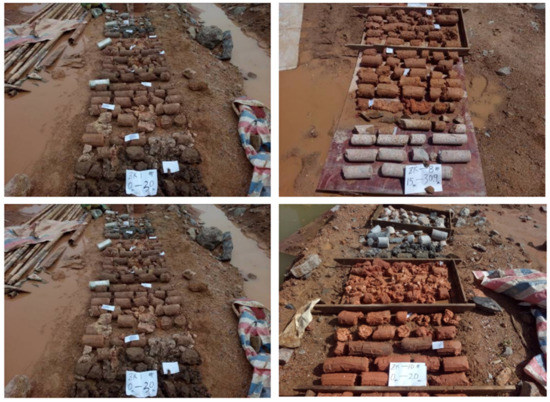
Figure 1.
Drilling and sampling test.
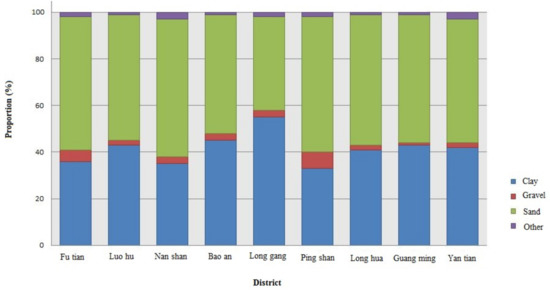
Figure 2.
Excavated soil composition in each district of Shenzhen.
In general, the soil is composed of solid (minerals, organic matter), liquid (soil water and solution), and gaseous (soil air) phases. The compounds SiO2, Al2O3, and Fe2O3 account for more than 75% of the chemical composition of the minerals in the soil [42]. The excavated soil of Shenzhen is generally composed of clay, gravel, and sand. The principal components of gravel and sand include volcanic, metamorphic, and sedimentary rock. The clay is distinct due to the differences in geology and climate. The quantity of Shenzhen’s excavated soil was attained from the local bureau of housing and construction. In 2019, almost 70 million cubic meters of soil were generated in Shenzhen [37]. This number will continue to grow until Shenzhen’s subway construction is completed in 2035 [41].
2.3. Demand for Recycled Materials
Figure 3 indicates that the river sand price jumped by almost 227% over 11 months from 2017 to 2018 in Shenzhen. This rise in construction sand price is attributed to the imbalance between the supply and demand of sand. It is estimated that the amount of sand required for the concrete mixing station in Guangdong Province in 2018 was 68.4 million cubic meters, while the planned mining volume of river sand was only 3.933 million cubic meters (Statistical yearbook of Guangdong, 2018). Although the continued increase in infrastructure investment in Guangdong Province will simultaneously increase the demand for sand in the construction industry, there still remains a large gap between the supply and demand of sand, resulting in a sharp rise in the sand price.
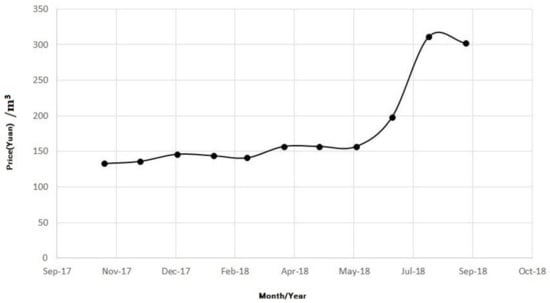
Figure 3.
Price trend of river sand for construction from 2017 to 2018 in Shenzhen.
2.4. Recycled Excavated Soil Process Description
The data described in Section 2.2 reveal the large amount of sand contained in Shenzhen’s excavated soil, making up approximately 57%. However, due to the solid plastic property of clay, existing sand extraction equipment cannot completely separate the clay from the sand [43,44]. In order to overcome this problem, we designed a new technological process and manufactured the related equipment to extract recycled sand from high-plastic clay. Figure 4 depicts the process flow of the designed equipment. The soil was excavated in the construction site and recycled on-site or transported to the stationary recycling plant. The excavated soil was sieved to ensure that the adequately sized soil (50 mm–100 mm) could be separated, retained, and subsequently sent to be evenly separated using the designed equipment. An iron remover collected any scrap steel that could cause damage to the separation equipment, and the soil was transferred into the separation equipment by the conveyor belt. The separation equipment extracted the recycled sand from the soil, and the recycled sand was sent to the spiral washer for further cleaning. Moreover, the coarse aggregates were placed into a pressure blasting machine, ground into sand, and transferred to the spiral washer. The flocculating agents were added into the slurry tank to attract clay to form precipitation in the slurry. The clay precipitation was then piped into the filter press to make the filter clay cakes. Finally, the recycled sand was transported to the construction site. The filter clay cakes and waste in the excavated soil were taken to the landfill or stationary plant and further recycled into filter clay cakes.
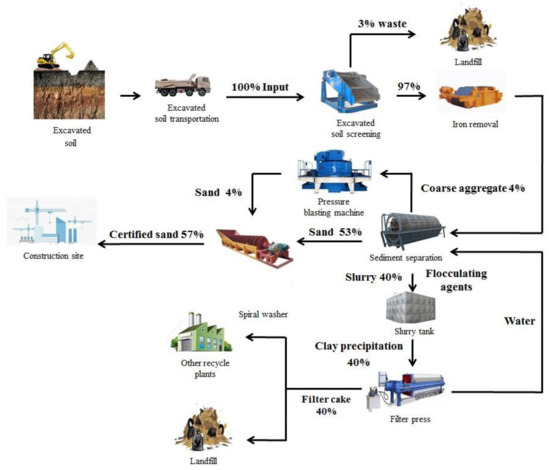
Figure 4.
Diagram of process flow for the recycled excavated soil.
2.5. Physical and Mechanical Properties of Recycled Sand
The physical and mechanical properties of the recycled sand samples (e.g., fineness module, apparent density, bulk density, clay content, gradation, void content, crush index, water absorptivity, and water demand of recycled mortar) were determined according to the Recycled fine aggregate for concrete and mortar (GB/T 25176-2010) and Sand for concrete (GB/T 14684-2011) standards.
2.6. Economic Evaluation
2.6.1. Total Investment and Operation Estimation
The total capital investment includes direct fixed capital and the startup cost (Shenzhen bureau of planning and nature resources, 2016). The fixed capital includes the stationary plant rental (there are no land and stationary plant costs in the on-site recycling model) and the expenses of purchasing and installing the separation equipment (e.g., water piping, electricity, cable, temporary buildings, land hardening, weighbridge, yard improvement, cleaning equipment, and auxiliary facilities). Table 1 reports the estimation details. The equipment costs were obtained from market inquiries, which refer to the manufactured equipment price in China. The processing power of the separation equipment used here was 200 t/h. The installation cost was equipment-specific (hoisting, welded steel pipe). The land cost was the average rental price of stationary plants in Shenzhen, while the startup cost was used to cover the stationary plant usage expenses in the startup phase (e.g., office supplies, insurance, and equipment testing). Furthermore, we assumed that no further capital cost or revenue was generated from the resale of stationary plant facilities after the stationary plant’s lifetime.
2.6.2. Revenue
Revenue is obtained from the sale of recycled sand and a service fee associated with the ‘excavated soil treatment’ paid by the construction enterprise. The current information price of recycled sand is USD 17.3/t, and the service fee of ‘excavated soil treatment’ is approximately USD 7.9/t (data from field research).
2.6.3. Profitability Analysis
The profitability of the two recycling models was researched by evaluating the net present value (NPV), internal rate of return (IRR), return on investment (ROI), payback period, production cost, minimum selling price, gross profit, and net profit. The gross profit is derived by deducting the annual operational cost from the annual revenue. It is an indicator of profitability. Added-value tax (3%) is also factored into the net profit. By discounting future cash flows to the present value, the net present value (NPV) (Equation (1)) establishes the model’s profitability over the lifespan of the complete recycling equipment (10 years). The procedure is profitable if the NPV is positive and vice versa.
where t is the lifetime (years); C0 is the initial investment; Ct is the net cash flow during period t; and d is the discount rate.
The IRR is also an important indicator of investment efficiency and is equal to the discount rate at NPV = 0 (from Equation (1)). The payback period is the time it takes to recover the investment cost. At the same time, the cash return rate (without considering the residual value in the recycling equipment’s lifetime) is represented by the return on investment (ROI). Moreover, the ROI is defined as follows:
The cash flow trends over the stationary plant’s lifetime were evaluated using the cumulative cash flow for each year. In the discounted cash flow analysis, the IRR is a discount rate that makes the NPV of cash flows equal to zero. When the final cash value reached zero, the IRR’s numerical value was confirmed.
2.6.4. Sensitivity Analysis
Sensitivity analysis was performed to evaluate the impact of different variables on economic performance. The total sales revenue and production cost were independently evaluated and set at ±5% to ±50% variation at the beginning of the excavated soil recycling equipment’s lifetime. At an 8% discount rate, NPV was employed as the indicator.
3. Results
3.1. Mass Balance
The separation equipment has a maximum treatment capacity of 200 tons per hour and a total treatment of excavated soil of approximately 2000 tons per day (TPD). The working period was 10 h per shift, and the initial operation applied just one shift per day. Figure 4 illustrates the mass balance information throughout the soil separation process. On average, approximately 0.57 tons of recycled sand can be recycled when processing 1 ton of excavated soil. The disposal of other residual waste and clay must be processed by an additional landfill.
3.2. Separation Equipment and Production Tests
The separation equipment was set in a steel box to avoid noise and dust pollution. Figure 5 presents the ultimate configuration of the soil separation equipment. The excavated soil was shoveled into the feeding and separation system (Figure 5b), which not only removes the scrap steel that could cause damage to the separation equipment in the excavated soil and scrubs the excavated soil to produce fine aggregates, but also grinds the recycled sand to remove the sharp edges and angular elements on the particles to improve the shape. After scrubbing and grinding, the fine aggregates were fed into a screen to remove the big-size stones (≥4.75 mm) and control the grading of the fine aggregates. At last, the above materials were sent into the spiral washer to remove the fine silt remaining in the fine aggregates. After separating the recycled sand, the slurry was pumped into the concentrate and filter system to recycle water (Figure 5c). Finally, the recycled sand and filter cake were piled up via the collecting system (Figure 5d). Most of the filter cakes were transported to landfills following the aforementioned treatment. However, a small amount of sand remained in the filter cakes because of the fine sand recycling machine. Hence, the filter cakes were suitable for the manufacturing of ceramics. A new environment-friendly calcination craft that can reduce carbon emissions should thus be designed for the efficient manufacturing of filter cakes.
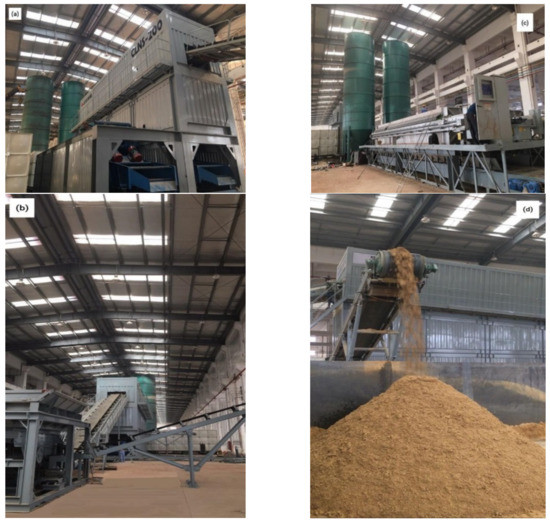
Figure 5.
Ultimate configuration of soil separation equipment: (a) overview; (b) feeding and separation system; (c) concentrate and filter system; and (d) recycled sand and filter cake collecting system.
3.3. Physical and Mechanical Properties
Although the excavated soil was collected from different foundation pits in construction sites across Shenzhen, the basic performances of the recycled sand exhibited minimal differences. Table 2 reports the physical and mechanical properties of the recycled sand, and Figure 6 depicts the corresponding grading curve. All the parameters (apparent density, bulk density, void content, fineness module, clay content, crush index, water absorptivity) meet the Chinese standard for technological requirements and test method, with the exception of the sand excavated from the soil using the tunnel boring machine, which is too fine to satisfy the standards.

Table 2.
Physical and mechanical properties of recycled sand.
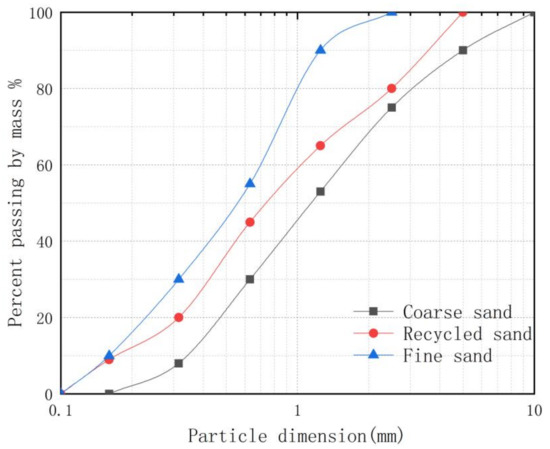
Figure 6.
Grading curve of recycled sand.
3.4. Total Capital Investment and Operating Costs
The fixed asset costs include equipment and construction, while the operating costs include land and stationary plant, labor, energy, water, flocculant, and disposal costs, as well as taxes. Note that there are no land and stationary plant costs in the on-site recycling model. The equipment, with a cost of USD 3,140,157, includes one excavated soil separation instrument, two forklifts, and one excavator. The disposal cost indicates filter cake landfill and transportation average tipping fees of USD 2,031,496 and USD 1,218,898, respectively, in 2020. The annual total operating costs were USD 6,481,732 and USD 3,068,346, respectively. The results suggest that the greater the operating cost, the larger the disposal fee.
3.5. Revenue and Profitability Analysis
Table 3 presents the revenues obtained by the stationary recycling plant. The profit comes from selling recycled sand and a service fee provided for the ‘excavated soil treatment’. The recycling stationary plant’s mean annual revenue is USD 7,912,254. The economic performance was evaluated by net present value (NPV), internal rate of return (IRR), return on investment (ROI), gross profit, net profit, payback period, and cash flow using a profitability analysis. The recycling stationary plant was profitable, as evidenced by the annual net profit generated (USD 1,283,386) and positive NPV (USD 6,776,378). The stationary plant is observed to be economically profitable for the excavated soil recycling case in terms of the IRR (28.03%) and ROI (31.4%). In addition, the shortest payback period is 3.68 years at an 8% discount rate (Figure 7a).

Table 3.
Revenue and profitability analysis for the recycling stationary plant in Shenzhen from 2019 to 2028.
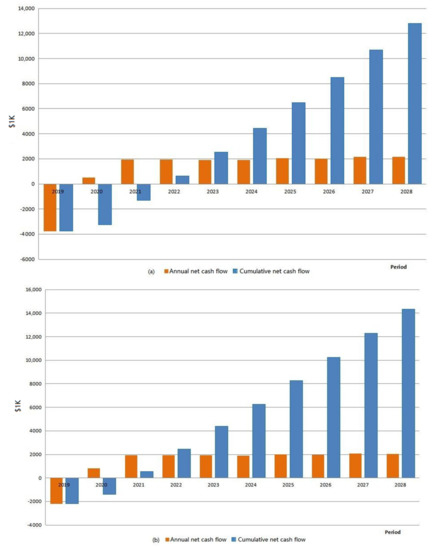
Figure 7.
Cash flow of two recycling modes in Shenzhen from 2019 to 2028: (a) recycling stationary plant model; (b) on-site recycling model.
Table 4 reports the revenues generated from the on-site recycling model. The profit is obtained from selling recycled sand and a service fee provided for the excavated soil treatment, as well as transportation charges that were translated into profit for the recycling of the excavated soil. The annual revenue of the on-site recycling model is USD 47,473,543. This model is observed to be more profitable than the stationary plant recycling case (USD 1,400,079) and positive NPV (USD 8,305,197), IRR (60.12%), and ROI (37.1%). In addition, the shortest payback period is 2.71 years at an 8% discount rate (Figure 7b). The economic performance was analyzed by estimating the capital investment, operation cost, and revenue generation. Profitability analysis, cumulative net cash flow, and sensitivity analysis were then conducted.

Table 4.
Revenue and profitability analysis of on-site excavated soil recycling in Shenzhen from 2019 to 2028.
3.6. Sensitivity Analysis
The recycling equipment had a planned operation period of 10 years, and thus fluctuations in the economic environment were anticipated, with the possibility of causing a risk of deficit to the business. We employed sensitivity analysis to determine which variable exerted the greatest economic impact on the recycling business. This was achieved by changing the most influential parameters (e.g., the service fee of excavated soil treatment, equipment costs, recycled sand sales, labor costs, disposal costs, and land and stationary plant costs). Parameters varied from ±5% to ±50% at the beginning of the recycling equipment’s lifetime. Figure 8a,b present the results.
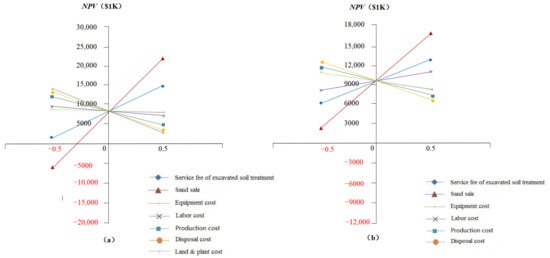
Figure 8.
Sensitivity analysis for the NPV: (a) the stationary plant recycling model; (b)the on-site recycling model.
The stationary plant recycling model is less sensitive to the equipment and labor costs. In particular, an increase in 50% of the equipment cost reduces the net profit rate, NPV, and IRR by 18.7%, 21.2%, and 49.6%, with a payback period of 4.6 years. Moreover, the recycled sand sale was identified to exert the greatest influence on the whole project. A decline of the recycled sand price by 5% will reduce the net profit rate, NPV and IRR by 14.5%, 18.3%, 23.1%, with a payback period of 4.0 years.
4. Discussion
The whole recycling process extracts more than 50% of the aggregate from the excavated soil, but there is still about 40% of the filter cake that has been landfilled, and this part of the material needs to be studied and resourcefully utilized in the future, to realize the complete comprehensive utilization of the excavated soil. With the elimination of technological impediments and increased quality control, demand will be expanded even further, which will allow the recycled products of excavated soil to be used not only for dam and road construction, but also for the production of cement, mortar, and structural concrete in buildings [45].
Based on the analysis described in 3, the cash flow of two models for excavated soil recycling was plotted and displayed in Figure 4. The shortest payback period is shown in the graph, which is around 3.68 years for stationary plant recycling and 2.71 years for on-site recycling. By contrast, several national legislative documents use an 8-year payback period to reference economic feasibility [14]. The shortest payback period for the on-site recycling model is one year less than the shortest payback period for the stationary plant recycling approach. At the same time, the IRR of the on-site recycling model is approximately twice as high as the IRR of the stationary plant recycling. However, the limitation of on-site recycling must be considered. Due to the schedule and process of the excavation project, on-site recycling cannot guarantee continuous operation, and its operation time is usually in a cycle of 3 to 5 months. When a process is completed, it is transported to another construction site to start a new recycling action.
The two recycling models both have a 200 tons/h installed capacity for excavated soil input and be able to dispose of 0.6 million tons (stationary plant recycling) and 0.36 million tons (on-site recycling) of excavated soil, respectively. The stationary plant recycling collects around USD 8.62 million in the first year of operation alone. With an overall annual cost over the plateau of operation of about USD 6.48 million, and even considering annual running costs of USD 7.53 million, revenue from recycled sand’s sales quickly supersedes total accumulated costs. On the other hand, on-site recycling collects around USD 5.17 million with less annual operating cost and working hours in the plateau. At today’s prices, this economic model presents overall benefits for the entire ten-year period of almost USD 79.12 million (stationary plant recycling) and USD 47.47 million (on-site recycling), solely from service fee for excavated soil treatment and recycled sand sales; only USD 69.64 million (stationary plant recycling) and USD 32.82 million (on-site recycling) are attributed to costs in the same period, which offers the owner USD9.47 million (stationary plant recycling) and USD 14.66 million (on-site recycling) surplus. respectively. The comparison reveals that stationary plant recycling disposed of more excavated soil, while on-site recycling is more efficient and profitable.
It assumes ideal operating conditions, such as a service fee for excavated soil treatment, a sale price for recycled sand, equipment costs, labor costs, production costs, disposal costs, and site rental costs that are as high as those estimated. As these conditions can and will likely change when the facility is installed, a sensitivity analysis of their influence on NPV was conducted. Similar to the stationary plant recycling model, the on-site recycling model is not very sensitive to equipment and labor costs. Although both models are sensitive to the recycled sand price, the fluctuation range of the on-site recycling model is smaller than that of the stationary plant recycling model. A 5% reduction of the recycled sand price will reduce the net profit rate, NPV, and IRR by 8.0%, 8.9%, and 10%, respectively, with a payback period of 4.0 years. It should be observed that the sale of recycled sand accounts for more than 80 percent of all benefits, making this a potentially revenue-critical issue. As costs are more evenly divided among equipment, labor, production, disposal, and site rental, fluctuations in disposal fees can alter the profitability of excavated soil recycling business. In general, a high recycled sand price is the most critical factor in ensuring the smooth running of the recycling business. However, the market constantly changes, with recycled sand prices commonly fluctuating. The recycling company should thus develop additional products to avoid dependency on a single product and the risk of its fluctuating price.
This paper was conducted in Shenzhen, China, and the composition of the excavated soil, the prices of recycled sand, land rent, and disposal fees used in the paper are regional. Therefore, the generalization of this analysis to other geographical regions should take this factor into account. The sediment separation technology for the excavated soil recycling were reduced by about 30–70% of the total amount of excavated soil, but the filter cake still needs to be landfilled. Thus, it is necessary to improve the technological processes for the excavated soil’s recycling to achieve the goal of total recycling for excavated soil.
5. Conclusions
Comprehensive information on excavated soil composition was obtained by sampling 108 in situ drilling holes in nine districts of Shenzhen. The average soil composition data show that there are giant sand and gravel resources in the excavated soil. Nevertheless, the high plastic property of the excavated soil prevented the feasibility of recycling.
The designed excavated soil recycling process offers the feasibility of recycling highly plastic excavated soils. Moreover, the sediment separation equipment extracts the recycled sand from the excavated soil successfully. Although the excavated soil was collected from different construction sites across Shenzhen, the physical and mechanical properties of the recycled sand exhibited minor differences. Therefore, it is feasible to supply recycled sand to the construction material market as a commodity of consistent quality.
As a result of the research and development of the recycling technology for excavated soil following the marketing requirements, the shortcomings of the mainstream recycled products, which are unprofitable, have been overcome. Both the stationary plant and on-site recycling models for the excavated soil exhibit good economic performance. The stationary plant recycling model costs USD 314,961 more in fixed asset investments than the on-site recycling model and USD 3.42 million more in operating costs in 2020. The ROIs of the stationary plant and on-site recycling models are 31.4% and 37.1%, respectively. Since on-site recycling does not have stationary plant and land costs, recycled products have a higher net profit. Whereas, the annual production capacity of the on-site recycling model is smaller than that of the stationary plant recycling model.
The parameter that was found to have the greatest impact on stationary plant and on-site recycling models through the use of sensitivity analysis is the recycled sand sale price, followed by the service fee provided for the ‘excavated soil treatment’. The highest operating cost for both recycling models is determined as the filter cakes disposal fee.
Author Contributions
Conceptualization, T.H. and S.K.; investigation, D.L. (Deyou Liu); writing—original draft preparation, T.H.; writing—review and editing, S.K., D.L. (Dawang Li) and F.X. All authors have read and agreed to the published version of the manuscript.
Funding
This research was funded by the Key-Area Research and Development Program of Guangdong Province (Project No. 2019B111107003).
Institutional Review Board Statement
Not applicable.
Informed Consent Statement
Informed consent was obtained from all subjects involved in the study.
Data Availability Statement
All data, models, and code generated or used during the study appear in the submitted article.
Conflicts of Interest
The authors declare no conflict of interest.
References
- Zheng, L.; Wu, H.; Zhang, H. Characterizing the generation and flows of construction and demolition waste in China. Constr. Build. Mater. 2017, 136, 405–413. [Google Scholar] [CrossRef] [Green Version]
- National Bureau of Statistics of the People’s Republic of China (NBSC). China City Statistical Yearbook; China Statistics Press: Beijing, China, 2002–2019. [Google Scholar]
- Solís-Guzmán, J.; Marrero, M.; Montes-Delgado, M.V. A Spanish model for quantification and management of construction waste. Waste Manag. 2009, 29, 2542–2548. [Google Scholar] [CrossRef] [PubMed]
- Yuan, H.; Shen, L. Trend of the research on construction and demolition waste management. Waste Manag. 2011, 31, 670–679. [Google Scholar] [CrossRef] [PubMed]
- Xu, W.; Zhou, M.; Zhou, W. Shenzhen Landslide Sounds Alarm on Construction Waste. The China Daily. 25 December 2015. Available online: https://www.straitstimes.com/asia/east-asia/shenzhen-landslide-sounds-alarm-on-construction-waste-the-china-daily (accessed on 11 January 2021).
- Banias, G.; Achillas, C.; Vlachokostas, C. Assessing multiple criteria for the optimal location of a construction and demolition waste management facility. Build. Environ. 2010, 45, 2317–2326. [Google Scholar] [CrossRef]
- Duan, H.; Wang, J.; Huang, Q. Encouraging the environmentally sound management of C&D waste in China: An integrative review and research agenda. Renew. Sustain. Energy Rev. 2015, 43, 611–620. [Google Scholar]
- Akhtar, A.; Sarmah, A.K. Construction and demolition waste generation and properties of recycled aggregate concrete: A global perspective. J. Clean. Prod. 2018, 186, 262–281. [Google Scholar] [CrossRef]
- Martín-Morales, M.; Zamorano, M.; Ruiz-Moyano, A.; Valverde-Espinosa, I. Characterization of recycled aggregates construction and demolition waste for concrete production following the Spanish Structural Concrete Code EHE-08. Constr. Build. Mater. 2011, 25, 742–748. [Google Scholar] [CrossRef]
- Behera, M.; Bhattacharyya, S.K.; Minocha, A.K.; Deoliya, R. Recycled aggregate from C&D waste & its use in concrete—A breakthrough towards sustainability in construction sector: A review. Constr. Build. Mater. 2014, 68, 501–516. [Google Scholar]
- Shahidan, S.; Azmi, M.A.M.; Kupusamy, K. Utilizing Construction and Demolition (C&D) Waste as Recycled Aggregates (RA) in Concrete. Procedia Eng. 2017, 174, 1028–1035. [Google Scholar]
- Peng, C.; Scorpio, D.; Kibert, C. Strategies for successful construction and demolition waste recycling operations. Constr. Manag. Econ. 1997, 15, 49–58. [Google Scholar] [CrossRef]
- Oliveira, N.; Geraldo, C.; Correia, J.M.F. Environmental and economic advantages of adopting reverse logistics for recycling construction and demolition waste: A case study of Brazilian construction and recycling companies. Waste Manag. Res. 2019, 37, 176–185. [Google Scholar] [CrossRef] [PubMed]
- Coelho, A.; de Brito, J. Environmental analysis of a construction and demolition waste recycling plant in Portugal—Part I: Energy consumption and CO2 emissions. Waste Manag. 2013, 33, 1258–1267. [Google Scholar] [CrossRef] [PubMed]
- Nunes, K.R.A.; Mahler, C.F.; Valle, R.; Neves, C. Evaluation of investments in recycling centres for construction and demolition wastes in Brazilian municipalities. Waste Manag. 2007, 27, 1531–1540. [Google Scholar] [CrossRef] [PubMed]
- Bao, Z.; Lu, W. Developing efficient circularity for construction and demolition waste management in fast emerging economies: Lessons learned from Shenzhen. China. Sci. Total Environ. 2020, 724, 138264. [Google Scholar] [CrossRef]
- Duran, X.; Lenihan, H.; O’Regan, B. A model for assessing the economic viability of construction and demolition waste recycling—the case of Ireland. Resour. Conserv. Recycl. 2006, 46, 302–320. [Google Scholar] [CrossRef]
- Wilburn, D.R.; Goonan, T.G. Aggregates from natural and recycled sources. In US Geological Survey Circular; US Department of the Interior: Washington, DC, USA, 1998. [Google Scholar]
- Tam, V.W.Y. Comparing the implementation of concrete recycling in the Australian and Japanese construction industries. J. Clean. Prod. 2009, 17, 688–702. [Google Scholar] [CrossRef]
- Jung, J.-S.; Song, S.-H.; Jun, M.-H.; Park, S.-S. A comparison of economic feasibility and emission of carbon dioxide for two recycling processes. KSCE J. Civ. Eng. 2015, 19, 1248–1255. [Google Scholar] [CrossRef]
- G’alvez-Martos, J.-L.; Styles, D.; Schoenberger, H.; Zeschmar-Lahl, B. Construction and demolition waste best management practice in Europe. Resour. Conserv. Recycl. 2018, 136, 166–178. [Google Scholar] [CrossRef] [Green Version]
- Hu, M.; He, Q.; Shi, S.; Qi, D. Cost Analysis of Construction and Demolition Waste Management: Case of Chongqing. Constr. Econ. 2011, 4, 93–97. [Google Scholar]
- Iacoboaea, C.; Aldea, M.; Petrescu, F. Construction and demolition waste-a challenge for the European Union? Theor. Empir. Res. Urban Manag. 2019, 14, 30–52. [Google Scholar]
- Katsumi, T. Soil excavation and reclamation in civil engineering: Environmental aspects. Soil Sci. Plant Nutr. 2015, 61, 22–29. [Google Scholar] [CrossRef]
- Baum. Amounts and composition of construction waste from residential buildings. In International RILEM Conference on the Use of Recycled Materials in Building and Structures; RILEM Publications SARL: Grisons, Switzerland, 2004; pp. 201–207. [Google Scholar]
- Ocak, I. Environmental problems caused by Istanbul subway excavation and suggestions for remediation. Environ. Geol. 2009, 58, 1557. [Google Scholar] [CrossRef]
- Zhang, Y.; Lu, W.; Chen, M.; Yan, P.; Hu, Y. Dam foundation excavation techniques in China: A review. J. Rock Mech. Geotechnol. Eng. 2013, 460–467. [Google Scholar] [CrossRef] [Green Version]
- Chittoori, B.; Puppala, A.J.; Reddy, R.; Marshall, D. Sustainable reutilization of excavated trench material. In GeoCongress 2012: State of the Art and Practice in Geotechnological Engineering; ASCE: Reston, VI, USA, 2012; pp. 4280–4289. [Google Scholar]
- Riviera, P.P.; Bellopede, R.; Marini, P.; Bassani, M. Performance-based re-use of tunnel muck as granular material for subgrade and sub-base formation in road construction. Tunn. Undergr. Space Technol. 2014, 40, 160–173. [Google Scholar] [CrossRef] [Green Version]
- Mlinar, C.; Sempelmann, F.; Koch, G.; Steiner, M.; Kubin, F. Tunnel spoil as a source of raw materials for an autobahn–Sustainable reuse of resources through the example of the S 10/Tunnelausbruch als Rohstoffquelle für eine Autobahn–Nachhaltige Ressourcenverwertung am Beispiel der S 10. Geomech. Tunn. 2014, 7, 428–436. [Google Scholar] [CrossRef]
- Zhao, H.-L.; Liu, F.; Liu, H.-Q.; Wang, L.; Zhang, R.; Hao, Y. Comparative life cycle assessment of two ceramsite production technologies for reusing municipal solid waste incinerator fly ash in China. Waste Manag. 2020, 447–455. [Google Scholar] [CrossRef]
- Dai, D.; Peng, J.; Zhao, X.; Li, G.; Bai, L. Strength and Road Performance of Superabsorbent Polymer Combined with Cement for Reinforcement of Excavated Soil. Adv. Civ. Eng. 2021, 2021, 9170431. [Google Scholar] [CrossRef]
- Al-Fakih, A.; Mohammed, B.S.; Liew, M.S. Incorporation of waste materials in the manufacture of masonry bricks: An update review. J. Build. Eng. 2019, 21, 37–54. [Google Scholar] [CrossRef]
- Ding, Y.; Zhao, J.; Liu, J.-W.; Zhou, J.; Cheng, L.; Zhao, J.; Shao, Z.; Iris, Ç.; Pan, B.; Li, X.; et al. A review of China’s municipal solid waste (MSW) and comparison with international regions: Management and technologies in treatment and resource utilization. J. Clean. Prod. 2021, 293, 126–144. [Google Scholar] [CrossRef]
- Huang, Y.; Wang, L. Effect of Particle Shape of Limestone Manufactured Sand and Natural Sand on Concrete. Procedia Eng. 2017, 210, 87–92. [Google Scholar]
- Zhang, N.; Duan, H.; Sun, P. Characterizing the generation and environmental impacts of subway-related excavated soil and rock in China. J. Clean. Prod. 2020, 248, 119242. [Google Scholar] [CrossRef]
- Voit, K.; Kuschel, E. Rock material recycling in tunnel engineering. Appl. Sci. 2020, 10, 2722. [Google Scholar] [CrossRef] [Green Version]
- Bellopede, R.; Brusco, F.; Oreste, P.; Pepino, M. Main aspects of tunnel muck recycling. Am. J. Environ. Sci. 2011, 7, 338–347. [Google Scholar] [CrossRef]
- Priyadharshini, P.; Ramamurthy, K.; Robinson, R. Excavated soil waste as fine aggregate in fly ash based geopolymer mortar. Appl. Clay Sci. 2017, 146, 81–91. [Google Scholar] [CrossRef]
- Shenzhen Bureau of Planning and Nature Resources. Shenzhen Rail Transit Network Planning (2016–2030). Available online: http://www.sz.gov.cn/szzt2010/wgkzl/glgk/jgxxgk/gtzy/201612/P020161229356978181405.pdf (accessed on 15 October 2021).
- Hong, H.; Gu, Y.; Li, R.; Zhang, K.; Li, Z. Clay mineralogy and geochemistry and their palaeoclimatic interpretation of the Pleistocene deposits in the Xuancheng section, southern China. J. Quat. Sci. 2010, 25, 662–674. [Google Scholar] [CrossRef]
- Boers, M. Effects of a Deep Sand Extraction Pit: Final Report of the PUTMOR Measurements at the Lowered Dump Site. 2005. Available online: https://puc.overheid.nl/rijkswaterstaat/doc/PUC_117081_31/1/ (accessed on 12 January 2021).
- Kubicki, A.; Manso, F.; Diesing, M. Morphological evolution of gravel and sand extraction pits, Tromper Wiek, Baltic Sea. Estuar. Coast. Shelf Sci. 2007, 71, 647–656. [Google Scholar] [CrossRef]
- Ismail, S.; Ramli, M. Engineering properties of treated recycled concrete aggregate (RCA) for structural applications. Constr. Build. Mater. 2013, 44, 464–476. [Google Scholar] [CrossRef]
- Silva, R.V.; de Brito, J.; Dhir, R.K. Use of recycled aggregates arising from construction and demolition waste in new construction applications. J. Clean. Prod. 2019, 236. [Google Scholar] [CrossRef]
Publisher’s Note: MDPI stays neutral with regard to jurisdictional claims in published maps and institutional affiliations. |
© 2022 by the authors. Licensee MDPI, Basel, Switzerland. This article is an open access article distributed under the terms and conditions of the Creative Commons Attribution (CC BY) license (https://creativecommons.org/licenses/by/4.0/).